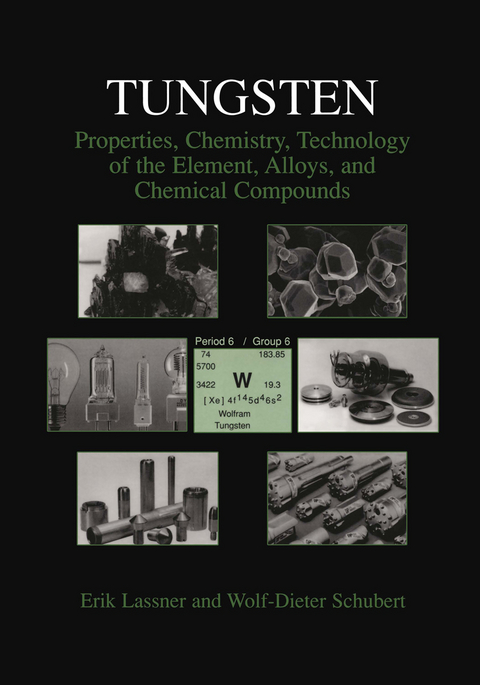
Tungsten
Kluwer Academic/Plenum Publishers (Verlag)
978-0-306-45053-2 (ISBN)
Why does someone write a book about Tungsten? There are several reasons and precedents for this, the most important of which is that the last book on tungsten was written more than 20 years ago, in 1977, by St. W H. Yih and Ch T. Wang. During the intervening period there have been many new scientific and technological developments and innova tions, so it was not only our opinion but the view of many other members of the "tungsten family" that it was time to start writing a new book about tungsten. Preparations of the new book began in 1994. further impetus to the project was provided by the realization that in spite of this new knowledge having been presented at seminars or published in the technical press, a general acknowledgement of it by the majority of technicians and scientists is still far from being realized. It is our hope that this book will significantly contribute to a broader acceptance of recent scientific and technological innovations. An important prerequisite for such a project is the availability of a recently retired, experienced person willing to devote his time and talents to the tedious part of the exercise.
1. The Element Tungsten: Its Properties.- 1.1. Analogous to Atom Related Physical Properties.- 1.2. Bulk Tungsten Metal Related Physical Properties.- 1.3. Chemical Properties of Tungsten Metal.- References for Chapter 1.- 2. Tungsten History: From Genesis to the 20th Century Products.- 2.1. The Formation of Tungsten Atoms.- 2.2 How Tungsten Atoms Came on Earth.- 2.3. Average Abundance.- 2.4. Geology: Formation of Ore Deposits.- 2.5. Minerals.- 2.6. Ore Deposits and Reserves.- 2.7. Early Discoveries of Ores, Compounds, and of the Element.- 2.8. Technically Important Discoveries.- 2.9. Industrial Evolution.- References for Chapter 2.- 3. Important Aspects of Tungsten Chemistry.- 3.1. Oxidation of Tungsten Metal by Air or Oxygen.- 3.2. Reaction of Tungsten with Water.- 3.3. Reduction of Tungsten Oxides by Hydrogen.- 3.4. Reduction of Tungsten Oxides by Carbon or Carbon-Containing Compounds.- 3.5. Reduction of Tungsten Halides.- 3.6. Reaction of Tungsten with Carbon or Carbon-Containing Compounds (Carburization).- 3.7. Chemistry of Aqueous Tungsten Solutions.- 3.8. Electrochemistry of Tungsten.- References for Chapter 3.- 4. Tungsten Compounds and Their Application.- 4.1. Tungsten and Metals: Intermetallic Compounds and Phases.- 4.2. Tungsten and Nonmetals.- 4.3. Mixed Ligand and Coordination Compounds of Tungsten.- 4.4. Organometallic Tungsten Compounds.- References for Chapter 4.- 5. Industrial Production.- 5.1. Mining and Ore Beneficiation.- 5.2. Hydrometallurgy.- 5.3. The Highly Pure Intermediates.- 5.4. Tungsten Metal Powder Production.- 5.5. Powder Metallurgy.- 5.6. Alternative Processes.- 5.7. Special Tungsten Forms and Qualities.- References for Chapter 5.- 6. Tungsten Alloys.- 6.1. Substitutional Alloys (Solid-Solution Alloys).- 6.2. Dispersion-Strengthened and Precipitation-Hardening Alloys.- 6.3. Tungsten Composites.- References for Chapter 6.- 7. Tungsten and Tungsten Alloy Products.- 7.1. Lighting Application.- 7.2. Electrical Engineering.- 7.3. Electronics.- 7.4. High-Temperature Technique.- 7.5. Welding, Cutting, Plasma Spraying, Spark Erosion, and Vapor Deposition.- 7.6. X-Rays, Radiation, Medical Engineering.- 7.7. Mechanical and Engine Engineering.- 7.8. Leisure Time and Sports Equipment.- 7.9. Chemical Industry and Metallurgy.- 7.10. Space Aviation.- 7.11. Military Applications.- 7.12. Aviation.- 7.13. Laser Technique.- References for Chapter 7.- 8. Tungsten in Melting Metallurgy.- 8.1. Tungsten in Steel.- 8.2. Superalloys.- 8.3. Stellite Alloys.- References for Chapter 8.- 9. Tungsten in Hardmetals.- 9.1. Introduction.- 9.2. Raw Materials.- 9.3. Hardmetal Production.- 9.4. Hardmetal Qualities and Applications.- References for Chapter 9.- 10. Tungsten in Catalysis.- 10.1. Metallic Tungsten.- 10.2. Oxides.- 10.3. Halides.- 10.4. Carbon Compounds.- 10.5. Organotungsten Compounds: Catalysts in ROMP and ADMET.- 10.6. Tungstates.- 10.7. Chalkogenides.- References for Chapter 10.- 11. Tungsten Scrap Recycling.- 11.1. Introduction and General Considerations.- 11.2. Tungsten Recycling Methods.- References for Chapter 11.- 12. Ecology.- 12.1. Introduction.- 12.2. Mining and Ore Dressing.- 12.3. Chemical Conversion.- 12.4. Powder Metallurgy.- 12.5. Environmental Considerations about the Substitution of High Speed Steel by Hardmetals.- References for Chapter 12.- 13. Economy.- 13.1. Introduction.- 13.2. World Mine Production.- 13.3. Price of Tungsten.- 13.4. Supply and Demand.- 13.5. Consumption and Use.- 13.6. The “International Tungsten Industry Association” (ITIA).- References for Chapter 13.- 14. Tungsten and LivingOrganisms.- 14.1. Introduction.- 14.2. Tungsten in Bacteria (Tungsten Enzymes).- 14.3. Tungsten and Animals.- 14.4. Tungsten and Humans.- References for Chapter 14.
| Zusatzinfo | XXI, 422 p. |
|---|---|
| Verlagsort | New York |
| Sprache | englisch |
| Maße | 178 x 254 mm |
| Themenwelt | Medizin / Pharmazie ► Medizinische Fachgebiete ► Neurologie |
| Naturwissenschaften ► Chemie ► Anorganische Chemie | |
| Technik ► Maschinenbau | |
| ISBN-10 | 0-306-45053-4 / 0306450534 |
| ISBN-13 | 978-0-306-45053-2 / 9780306450532 |
| Zustand | Neuware |
| Haben Sie eine Frage zum Produkt? |
aus dem Bereich


